- Home
- Michael Newton
The Texarkana Moonlight Murders: The Unsolved Case of the 1946 Phantom Killer
The Texarkana Moonlight Murders: The Unsolved Case of the 1946 Phantom Killer Read online
Also by MICHAEL NEWTON AND FROM MCFARLAND
* * *
The FBI Encyclopedia (2003; paper 2012)
The Mafia at Apalachin, 1957 (2012)
Chronology of Organized Crime Worldwide, 6000 B.C.E. to 2010 (2011)
The Ku Klux Klan in Mississippi: A History (2010)
The FBI and the KKK: A Critical History (2005; paper 2009)
Mr. Mob: The Life and Crimes of Moe Dalitz (2009)
The Ku Klux Klan: History, Organization, Language, Influence and Activities of America’s Most Notorious Secret Society (2007)
Encyclopedia of Cryptozoology: A Global Guide to Hidden Animals and Their Pursuers (2005)
The Texarkana Moonlight Murders
The Unsolved Case of the 1946 Phantom Killer
Michael Newton
McFarland & Company, Inc., Publishers
Jefferson, North Carolina, and London
LIBRARY OF CONGRESS CATALOGUING DATA ARE AVAILABLE
BRITISH LIBRARY CATALOGUING DATA ARE AVAILABLE
e-ISBN: 978-1-4766-0578-4
© 2013 Michael Newton. All rights reserved
No part of this book may be reproduced or transmitted in any form or by any means, electronic or mechanical, ?including photocopying or recording, or by any information storage and retrieval system, without ?permission in writing from the ?publisher.
Cover photograph © 2013 iStockphoto.com/Thinkstock
McFarland & Company, Inc., Publishers
Box 611, Jefferson, North Carolina 28640
www.mcfarlandpub.com
In memory of
Chuck Pierce
Table of Contents
Preface
1. Lover’s Lane
2. “Texarkana: Twice as Nice!”
3. Rich Road
4. Last Dance
5. Lone Wolf
6. Rampage
7. Madhouse
8. Prime Suspect?
9. Poison Pens
10. No Stone Unturned
11. Still at Large?
Conclusion
Chapter Notes
Bibliography
List of Names and Terms
Preface
Fifteen years before German author Siegfried Kracauer coined the term “serial murder,” a masked killer terrorized the town of Texarkana, on the Texas–Arkansas border. Striking five times within a ten-week period, always at night, the prowler claimed six lives and left three other victims wounded, traumatized for life. Survivors told police that their assailant was a man, but little else is known. A local newspaper dubbed him the Phantom Killer, and it stuck.
For reasons still unclear, other reporters called the faceless predator the “Moonlight Murderer,” suggesting that his actions were determined by a lunar cycle—though, in fact, none of the crimes occurred on a full moon. Neither, as some authors still assert, did the attacks take place at neatly measured three-week intervals. Nearly a month elapsed between the first and second crimes; the sixth murder occurred a mere four days after the fifth.
Texarkana’s phantom was not America’s first serial slayer; he certainly was not the worst, either in body count or sheer brutality. But he has left a crimson mark on history as one of those who got away. Like the elusive Axeman of New Orleans, Cleveland’s Mad Butcher of Kingsbury Run, and San Francisco’s Zodiac, the Phantom Killer left a haunting mystery behind.
And thereby hangs the tale.
My research on the “moonlight murders” spanned three decades and accumulated debts for help along the way. I owe special thanks to David Frasier, longtime friend, fellow author, and peerless researcher, at Indiana University’s Lilly Library; to Glenn Ferguson, for details of his interviews with key investigators; to Holly Cook, librarian at Texarkana College; to Wayne Gray, at the Texas/Dallas History and Archives division of the Dallas Public Library; to Jason Clark, public information officer with the Texas Department of Criminal Justice; to Gloria George, with the Arkansas Department of Corrections Records Department; to Larry Johnson, Oklahoma collection coordinator at the Oklahoma City Downtown Library; to Rhonda Morrow at the Texarkana Gazette; to W. H. McGee, former chief of police in Texarkana, Texas; to the Periodicals section of the Main Library in Fort Lauderdale, Florida; to Bob Sullivan, Schenectady County Public Library; to Jim Tackitt; and to the ever-helpful staff at the Brown County (Indiana) Library for their assistance with interlibrary loans. My wife, Heather, was supportive as always during my excursions on dark paths which are as alien to her as any Martian landscape. Thanks for sticking with me, Sunshine.
The Texarkana Moonlight Murders examines the crimes as they happened. No names have been changed, nor events rearranged for dramatic effect. Any dialogue appears as it has been reported in the media or memoirs from participants in the events. There is no need to dramatize the case.
The facts are grim enough.
Chapter 1
Lover’s Lane
February 22, 1946
By 11:45 that Friday night, James Hollis and his paramour were finally alone. They had begun the evening with a double date, accompanied by James’s brother Bob and his girl, visiting the Strand Theater in downtown Texarkana for a showing of Universal’s latest monster rally, House of Dracula. Released eleven weeks earlier, the film provided chills aplenty for its time, starring John Carradine as the bloodthirsty Romanian count, Lon Chaney Jr. as the wolf man, and future Gunsmoke bartender Glenn Strange as Frankenstein’s monster.1
After the movie, Hollis made good time driving their two backseat companions home, then aimed his father’s Plymouth north from town, toward Richmond Road. He had promised to return the car by midnight, more or less, but now responsibility was sacrificed to passion. Off of Richmond Road, a mile from Texarkana, lay an unpaved country drive well known to lusty teens and outraged ministers alike as Lover’s Lane.2
Hollis—“Jimmy” to his many friends—was twenty-four years old, employed with his brother at a local insurance agency. His companion, Mary Jeanne Larey, was a nineteen-year-old divorcée described in newspaper accounts as a “lovely brunette,” her first marriage an unspoken casualty of the Second World War. They craved some private time, hence the last-minute race to Lover’s Lane that would become a nightmare odyssey of terror.3
Today, the site lies buried under asphalt, reconfigured as the parking lot of Texarkana’s Central Mall, but in 1946 it was a stretch of open, mostly isolated countryside, a mile and a half northwest of the Beverly neighborhood. The night was made for cuddling, with clear skies and a half-moon visible, the temperature holding at a brisk fifty degrees. Hollis checked his wristwatch as he parked the Plymouth, making sure they still had ample time.4
The lovers had been necking for a brief ten minutes, when a beam of light lanced through the driver’s window of the Plymouth. Startled, Hollis turned to find a hooded figure stooped beside the car. The mask was white, resembling a pillowcase with holes cut for the eyes and mouth. The prowler aimed his flashlight with one hand, a pistol with the other. His voice was gruff as he said, “I don’t want to kill you, fellow, so do what I say.”5
Hollis and Larey followed orders, stepping from the Plymouth on the driver’s side. The gunman eyed them for a moment through his mask, then snarled at Hollis, “Take off your goddamn britches.” Hollis balked at that, but Larey urged him to comply for safety’s sake. Hollis removed his slacks, standing embarrassed in his boxer shorts. When he was thus exposed, the gunman lunged and slammed his pistol twice onto the young man’s head.6
“The noise was so loud,”
Larey would later tell reporter Lucille Holland of the Texarkana Gazette, “I thought Jimmy had been shot. I learned later that the sound was his skull cracking.”7
Terrified, she picked up the discarded pants, removed Hollis’s wallet, and showed the masked man that he carried no cash. The gunman accused her of lying, insisting that she had a purse in the car, but again he was wrong. Enraged, he struck her down. Although he had a gun in one hand and a flashlight in the other, Mary Jeanne imagined that he’d clubbed her with a piece of metal pipe.8
As she struggled to her feet, the man told Mary Jeanne to run. She started toward a roadside ditch, then heard him shout for her to run down Lover’s Lane, toward Richmond Road. Complying, she heard grunts and groans behind her, as the gunman turned on Hollis, kicking him repeatedly.9
“It was hard for me to run,” Larey told Holland, “because I had on high-heeled shoes. I saw an old model car parked on the road facing our car. I stopped and looked inside, hoping that someone could help me, but there was no one in it. Just after I got past the car, the man overtook me and asked me why I was running. I told him it was because he told me to run. He called me a liar again and then I knew he was going to kill me.”10
But she was mistaken. The gunman slugged her again, then threw himself on top of Larey as she fell. Larey’s conflicting statements mask what happened next. Within a single interview she said that the man “attempted to sexually assault her,” and that “he did not rape her, but that he abused her terribly.” Time blurred for Mary Jeanne, until her captor finally stood up and backed away. Somehow, though dazed and bleeding from a scalp wound, Larey struggled to her feet and faced the gunman. Speaking through her tears, she told him, “Go ahead and kill me.” Later, she would say she spoke those words “because she would rather he did that than to touch and abuse her.”11
Four separate documents in Texas Ranger files describe Larey’s assault as an “attempted rape.”12 In fact, multiple sources now agree that Larey’s statement to police described an act broadly defined by law as “object rape”—in this case, penetration of the victim’s genitals by her attacker’s gun barrel.13
Instead of shooting Mary Jeanne, the stranger turned and walked back toward her date, left Larey standing by herself on Lover’s Lane. She bolted, leaving Hollis to his fate, running for half a mile or more until she reached a house and hammered on its door, screaming for help. While waiting desperately for an answer, Larey saw a car pass by and called out to its driver, but it kept going toward Richmond Road. It was a strange car, Larey later said, and not the same one she had seen parked on the road a short time earlier.14
Frustrated at the front door of the dark and silent house, she ran around one side and pounded on the backdoor, finally rousing the residents from sleep. They made their slow way to the door, examined Larey in the porch light’s glare, and let her in before placing a phone call to the county sheriff’s office.15
Meanwhile, back on Lover’s Lane, the gunman had departed. Jimmy Hollis regained consciousness and staggered in his underwear to Richmond Road, where he flagged down a passing car. The driver would not transport him, but sped away toward town and called the Texarkana Funeral Home, at Sixth and Main Streets. Founded in 1937, by Harry Everett and Howard Fuqua, the mortuary also had an ambulance that served the local hospital. Within a quarter of an hour, it was on its way to Lover’s Lane.16
First to arrive at the crime scene was Bowie County Sheriff W. H. Presley, carrying three Texarkana patrolmen as backup. Presley questioned Mary Jeanne and tried his best with Hollis, but the young man with the fractured skull kept fading in and out of consciousness. In lieu of wasting any further time, Presley placed both victims aboard the mortuary’s ambulance, for transport back to Texarkana Hospital.17
The hospital, on Pine Street, had been built in 1900, when three local physicians pooled their resources to incorporate the Pine Street Sanitarium. Starting with fifteen beds, it was renamed Texarkana Sanitarium and Training School for Nurses in 1905, and then became the Texarkana Hospital in 1920, boasting fifty beds and treating three thousand patients per year. Hollis arrived unconscious, was diagnosed with multiple skull fractures—various reports say two or three—and he was placed on the hospital’s critical list. Mary Jeanne was more fortunate, cleared for release after stitches closed up her scalp wound.18
On Lover’s Lane, police found Hollis’s discarded pants a hundred feet from where his blood had stained the ground. His father’s Plymouth was the only car remaining at the crime scene, and the older vehicle that Mary Jeanne reported passing while on foot would never be identified. As for the other car, which she saw driving past the house that ultimately gave her shelter, Sheriff Presley speculated that its driver was the gunman, fleeing north to Richmond Road, then west to Summerhill. Where he had gone from there, no one could say.19
Hollis spent the next three months in treatment for his injuries, with doctor’s orders to remain off work for half a year, while Larey suffered brutal nightmares and would ultimately leave the state, to live with relatives in Oklahoma. Neither could avoid repeated grillings by police, however, and their stories of the incident, while generally consistent, offered one peculiar difference.20
Both victims said that their attacker had been six feet tall and masked, but Hollis said he was a “young white man, under thirty,” whereas Mary Jeanne claimed that he was an African American—a “Negro,” in the parlance of the day, if not some more demeaning term. Over the next two months, investigating officers rejected Larey’s statement. Some of them badgered her, as Mary Jeanne told Lucille Holland, stubbornly insisting that she knew the gunman’s name and was protecting him, an allegation she denied for the remainder of her life.21
In terms of motive, the authorities discounted robbery and made no public mention of a sexual assault during the early phase of their investigation. They had no suspects, although one published report claims that six persons were arrested and released after questioning. It would have been convenient to assign a motive such as jealousy or personal revenge—more comforting, by far, than to imagine a random stalker at large.22
Another possible reason for downplaying Larey’s report of a black assailant was purely practical. Racial segregation was a fact of life in Texarkana in the 1940s, spawning paranoia and sporadic incidents of violence. Most recently, during America’s war against fascism, black resident Willie Vinson had been accused of “assaulting” a white woman. A racist mob seized Vinson on July 13, 1942, dragging him through Texarkana behind a car, before he was hanged from a cotton gin winch.23 Whether Sheriff Presley and his deputies were consciously attempting to avert more bloodshed, or were simply skeptical of Mary Jeanne’s account, her mention of an African American attacker was not publicized until mid–May, by which time all the bloodletting was finished and the Phantom Killer had retired.
But Mary Jeanne lived with his memory. A quarter-century later, she would tell another local journalist, “I’ll never forget that voice as long as I live.”24
The gunman, possibly a novice stalker, had been hesitant to kill in Lover’s Lane.
It was an error he would not repeat.
Chapter 2
“Texarkana: Twice as Nice!”
Texarkana is unique in the United States: a city almost perfectly divided by the borderline between two states, its twin halves presenting a single cohesive façade. Its post office—Arkansas limestone walls rising from a base of pink Texas granite—is the only one in America planted directly astride a state boundary. The local Chamber of Commerce lures tourists with a perky slogan—“Texarkana: Twice as Nice!”1
That image wavers under closer scrutiny, however. Texarkana has a history of violence.
The region’s first inhabitants were members of the prehistoric Caddoan Mississippian culture, established as early as 1500 B.C.E.2 Spanish conquistador Hernando de Soto arrived to disrupt their relatively peaceful lives in 1541, bearing the Requerimiento (“requirement” or “demand”) originally penned by Cast
illian jurist Juan López de Palacios Rubios three decades earlier. Proclaimed aloud to aborigines in Spanish, which they could not understand, that ultimatum read, in part:
Their Highnesses are kings and lords of these islands and land of Tierra-firme and some islands, and indeed almost all those to whom this has been notified, have received and served their Highnesses, as lords and kings, in the way that subjects ought to do, with good will, without any resistance, immediately, without delay, when they were informed of the aforesaid facts. And also they received and obeyed the priests whom their Highnesses sent to preach to them and to teach them our Holy Faith; and all these, of their own free will, without any reward or condition, have become Christians, and are so, and their Highnesses have joyfully and benignantly received them, and also have commanded them to be treated as their subjects and vassals; and you too are held and obliged to do the same.
If you do so, you will do well, and that which you are obliged to do to their Highnesses, and we in their name shall receive you in all love and charity, and shall leave you, your wives, and your children, and your lands, free without servitude, that you may do with them and with yourselves freely that which you like and think best, and they shall not compel you to turn Christians, unless you yourselves, when informed of the truth, should wish to be converted to our Holy Catholic Faith, as almost all the inhabitants of the rest of the islands have done. And, besides this, their Highnesses award you many privileges and exemptions and will grant you many benefits.
But, if you do not do this, and maliciously make delay in it, I certify to you that, with the help of God, we shall powerfully enter into your country, and shall make war against you in all ways and manners that we can, and shall subject you to the yoke and obedience of the Church and of their Highnesses; we shall take you and your wives and your children, and shall make slaves of them, and as such shall sell and dispose of them as their Highnesses may command; and we shall take away your goods, and shall do you all the mischief and damage that we can, as to vassals who do not obey, and refuse to receive their lord, and resist and contradict him; and we protest that the deaths and losses which shall accrue from this are your fault, and not that of their Highnesses, or ours, nor of these cavaliers who come with us.3

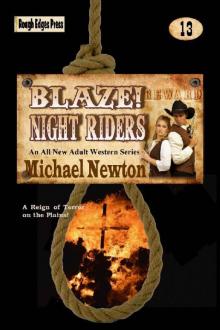 Blaze! Night Riders
Blaze! Night Riders How to Write Action Adventure Novels
How to Write Action Adventure Novels Blaze! Bad Medicine
Blaze! Bad Medicine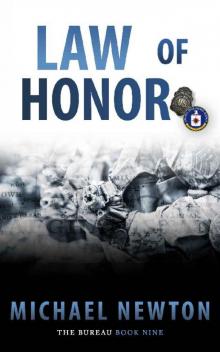 Law of Honor
Law of Honor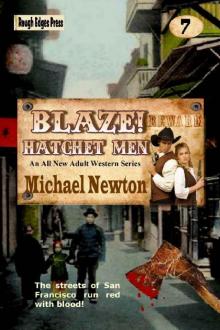 Blaze! Hatchet Men
Blaze! Hatchet Men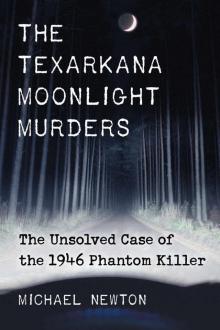 The Texarkana Moonlight Murders
The Texarkana Moonlight Murders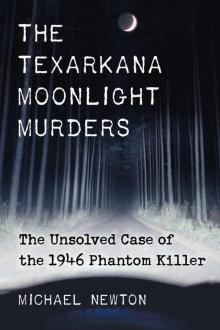 The Texarkana Moonlight Murders: The Unsolved Case of the 1946 Phantom Killer
The Texarkana Moonlight Murders: The Unsolved Case of the 1946 Phantom Killer